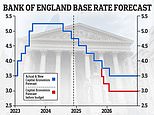How to turbocharge your pension wealth - and what mega-funds mean for YOUR retirement
There are no prizes for guessing the Chancellor’s favourite word. In Rachel Reeves’s first Budget speech, she said ‘growth’ 31 times – the equivalent of almost once every two minutes.
And by last week, her use of it was starting to look borderline obsessive. Her first Mansion House speech in the City was not half an hour long but she crammed in 41 mentions of ‘growth’.
It is becoming increasingly clear the Chancellor expects every aspect of the economy and all areas of society to feed her growth fixation. (Whether she is supporting them to do so is another matter.)
And her Mansion House speech gave a glimpse of how she expects pension savers to step up.
She outlined plans that would mean our pension savings are used to invest in major infrastructure projects and emerging industries.
This would be done by merging pension schemes (local government and defined contribution ones in particular) to create ‘mega-funds’ big enough to buy such massive assets. We’re likely talking airports, wind farms, bridges – investments that cost billions.

Rachel Reeves calling for growth in her Mansion House speech
She stopped short of mandating investment should be in UK assets. But that is what she is hoping for otherwise we would miss an opportunity for pension funds to drive – you’ve guessed it – growth in the economy.
So what does this mean for pension savers? First, she believes these plans will ‘unlock’ (another favourite word) £80billion of investment, which will boost the value of pension funds. But experts are divided on whether pensioners will see a benefit.
Second, if a deluge of cash is about to be directed towards UK assets, some experts believe there may be opportunities for individual investors to steal a march ahead of pension funds. Alex Campbell at investment platform Freetrade, is one of them.
‘With Rachel Reeves continuing the charge to consolidate pension funds and push them to invest in the economy, retail investors have attractive opportunities to get ahead of these changes,’ he says.
‘The trick in timing the market like this is always challenging though. Be prepared for ups and downs along the way – it’s unlikely a tap of billions in fresh capital will be turned on next week.’
Brian Byrnes, head of personal finance at investment platform Moneybox, agrees the pension megafund plans may create investing opportunities in infrastructure – but warns it could take years.
He says the Mansion House speech ‘is not enough for investors to change their asset allocation – they should continue to invest based on their risk appetite and financial objectives’.
He adds that investors should ‘keep an eye’ on any rules or guidance that are announced on how the megafunds will be created – as this will give a further indication of which types of investments could benefit, and when.
How to invest in infrastructure now
For investors wishing to take a punt on infrastructure, opportunities abound. However it is probably wise only to do so if you judge such investments on their merits, rather than in the hope of any boost from the pension reforms.
One fund that has piqued Alex Campbell’s interest is Greencoat UK Wind, which solely owns and operates UK wind farms. It is an investment trust and is trading on a 19 per cent discount.
The trust pays a dividend and aims to raise it in line with inflation. ‘The discount should start to narrow if more capital flows and interest rates fall,’ says Alex. ‘This could be an interesting entry point for investors looking to benefit from the income stream for years.’
He also mentions HICL Infrastructure, which invests primarily in UK assets such as railways, prisons and hospitals.
This investment trust is also trading at a discount, a substantial 22 per cent. If you’re not sold on the investment case for infrastructure, but buy into the growth rhetoric, the opportunities are more abundant.
Or should you just invest in 'cheap' UK stocks?
A word of caution though: growth fell to 0.1 per cent in the third quarter of this year.
And while Ms Reeves said hers was a Budget for growth, many disagree.
Ben Yearsley, investment consultant at Fairview Investing, says: ‘Business was whacked.’
Despite this, he is one of many experts who assert that the UK stock market is ‘very cheap with lots of great, well-run companies’.
He suggests investors could consider Vanguard UK Equity Income. This is a passive fund that follows an index made up of companies listed on the London Stock Exchange that are expected to pay dividends that are generally higher than average. It’s cheap to hold – just 0.14 per cent. A £1,000 investment three years ago would now be worth £1,297.
For investors who prefer an actively-managed fund, Ben mentions JO Hambro UK Equity Income, which invests in UK companies of all sizes, and Montanaro UK Smaller Companies Trust, which invests in small ones. The former costs 0.81 per cent a year and has turned a £1,000 investment into £1,236 over three years.




































































